
Aristides Arellano, Anja Arellano, Dafne Arellano
Dermatological Clinic and Aesthetic Surgery of Puebla, Puebla, Mexico.
*Corresponding author: Aristides Arellano, Dermatological Clinic and Aesthetic Surgery of Puebla, Puebla, Mexico.
Received Date: January 19, 2024
Accepted Date: January 25, 2024
Published Date: January 30, 2024
Citation: Arellano A, Arellano A, Arellano D. (2024) “Kelois Scars Treatment.” Journal of Dermatology and Venereology, 2(1); DOI: http;//doi.org/10.2024/11.1004.
Copyright: © 2024 Aristides Arellano. This is an open access article distributed under the Creative Commons Attribution License, which permits unrestricted use, distribution, and reproduction in any medium, provided the original work is properly cited.
22 cases have been done with this procedure since 2021, minimal complications have been observed. The Hybrid Laser Keloid technique is carried out using the ProScan, Pixel and Impact applicator, to get a better result and improve the patient satisfaction.
Hybrid device allows us to treat Keloid scars in any part of the face and body, we have been using the laser in Fitzpatrick skin tones 2 to 5. By employing the technique laser, a full scar restorartion is obtained with only 4 or 5 sessions. The patient recovery is quicker, and the corrective result is excellent.
hybrid CO2 laser; edema; redness; necrosis
Introduction
We start performing the patient selection taking in account the keloid scare location, skin color and patient pretentions, important matter in this subject because most of them want to see quickly results. However, it is needed between 4 or 5 weeks to recovery from the Hybrid CO2 laser to determine if there is need another session. This procedure time is around one hour and produces edema, redness, necrosis in some cases, a crust and patient discomfort. For that reason, we started applying an anesthetic cream 40 minutes before we start the laser application. It is carried out the Keloid resection approach with the CO2 laser in the cut mode in some cases.
Technique
Once the crème is retired from the scar zone, we infiltrate local anesthesia if is painful for the patient mostly in the auricular keloids. The laser is set up in the CO2 laser with the cut mode at 5 or 6 watts and is apply over and around the scar in the defocused way, (that mean that is not touching the skin is up approximately 2 to 3 mm above the scar).
When we finish burning the scar we wait until the necrosis or the crust came down (4 or 5 weeks later) and start using the Pixel hand peace at Energy 80, 7X7 and pulse duration 130 forming the skin tunnels that allows us to introduce the 5-Fluoracil solution with the Impact applicator with this parameters Frequency 50, impact 60 and temperature 67. After that we place a garment that is going to be retired buy the patient next day.
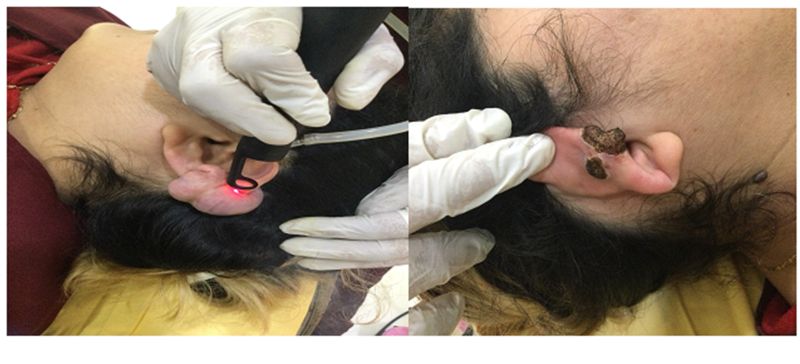 We recommend 5 sessions one every 2 to four weeks or when the crust is coming down.
We recommend 5 sessions one every 2 to four weeks or when the crust is coming down.
There is another way to apply the treatment that is a little more painful and takes more experience for the physician to be performed: consist of employing the laser in the Cut and Coagulate CO2 program at 4 watts, active time 34 ms and inactive time 30 ms and 2 mm spot in repeat mode. But the recovery time is shorter, and we can repeat the session every 2 weeks. Remember in unfocused way.
However, in cases where the surgical procedure can be performed, we employ only the CO2 laser at 5 watts in one pass. The laser is applied to resect the keloid scar after that because the tissue is burn is coagulated, there is no need for stiches just need to wait until the crust came down and star with the pixel and impact devices as we describe before. Even if the physician prefers, they can start infiltrating the 5 fluoroacil subdermal in the same day the laser was performed to prevent the formation of a new keloid scar.
As it was mentioned above, it is important to understand that the laser should be apply by a medical physician to avoid complications. In all cases where the surgical procedure was performed the close control recovery supervision is mandatory. Employing the CO2 laser at 5 watts there is no different skin color; texture or border remains in skin Fitzpatrick tones 2,3,4,5. With this method the redness and changes in color pigmentation disappear while the scar is healing, taking only 2 or 3 weeks for patient to get the same skin color and texture at the end of the treatment.
When the procedure was done an oily cream with antibiotic is used two or three times a day. An occlusive bandage is used by 48 hrs. helping to heal the skin more quickly. The cream application is used for 8 days, followed by a moisturizing cream with sun blackout at 100%. At night we recommend a moisturize cream mixed with sweet almonds, omega acids, ceramide, silicone oils, aloe Vera and kojic acid helping to decrease the redness, dry skin discomfort and avoid de hyper pigmentation. All these recommended items will depend on patient skin tone.
With these combined techniques the results are highly satisfactory because keloids Hybrid laser procedure is carried out in all areas where the scars more more often such as cheeks, arms, body, ears, neck, etc. The Hybrid laser method is used in those places where the surgery cannot be performed.
Statistics
Using Simple Random Sampling, the SAMPLE SIZE of 22 patients, on average, is representative of the general population. With a margin of error of 0.8 measurement units (plus 0.4, minus 0.4 of the true population value). This assertion is supported with 95% reliability.
The results obtained from 22 patients, using four complementary measuring scales (VANCOUVER with 3 variables, OSAS with 6 variables, POSAS OBS with 6 variables and POSAS PRET with 7 variables), to assess the effect of the treatment, measuring the before and after. Are presented below.
Vancouver Scale
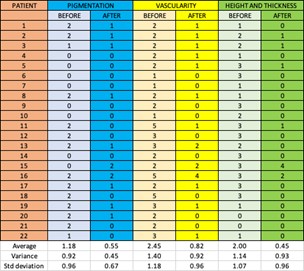
Osas Scale

POSAS (OBS)

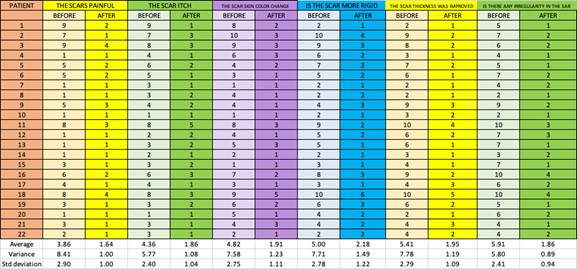
POSAS PRET
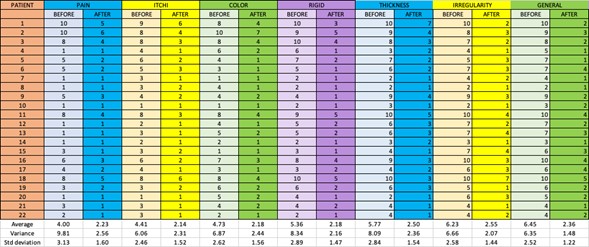
This result can be seen clearly and for the 22 variables in the graph of averages between before and after, which is presented below.
Comparative graph before vs after. Whit 4 scales
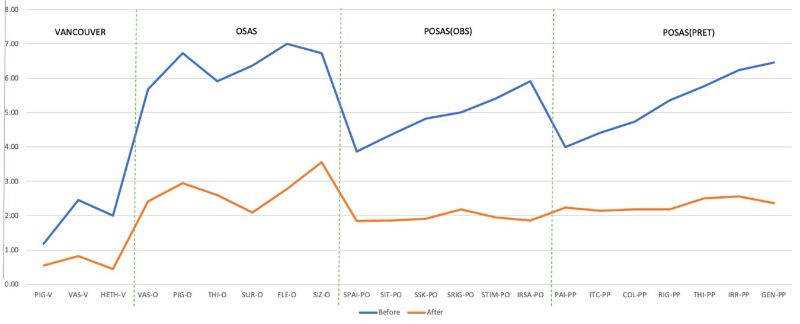
They demonstrate outstanding improvement, according to the 22 variables used.
The graph also shows that the VANCOUVER measurement scale is mor strict in pointing out differences between the treatment effect (before and after) and the other three scales also with their different criteria, but more confident in marking the differences. Highlight this fact with the pigmentation variable.
However, the fact is typical of any comparative study in which different measurement scales are used.
Only the Pigmentation variable assessed with the VANCOUVER team shows the greatest closeness between its results, before and after. That is why the Student t test was applied for related or paired samples (because it is the same person who is measured before and after).
The results are:
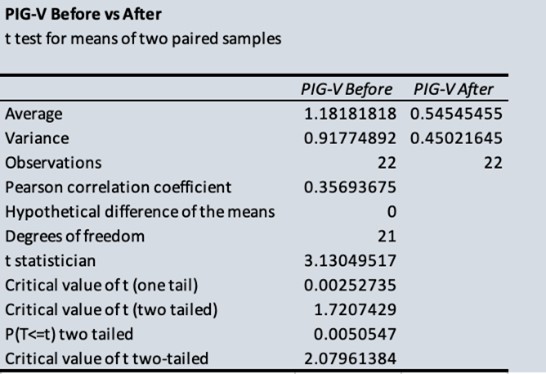
The results of the treatments between before and after are significantly different, with a probability much less than 5% (level of statistical significance probabilistic of the hypothesis test with value of 0.0050547 of two tailed).
This confirms statistically, that the treatment was beneficial in every sense based on the information provided by the 22 variables of the study.\
Conclusions
We have seen that performing this procedure, the patient results are much better. The keloid scars are carried out in a short time with the skin patient’s recovery almost at 100 %. In 4 to 6 months patient skin color is in the same tone. The skin looks smooth and is highly satisfactory. After employing this technique in many patients after 18 months we haven’t seen a keloid re appear.
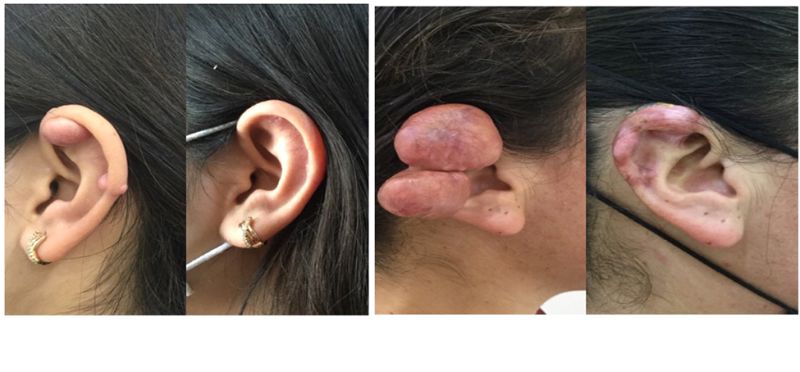 Co2 Unfocused Laser Treatment At 4 Watts And Impact Ultrasound With Transdermal 5 Fluorouracil
Co2 Unfocused Laser Treatment At 4 Watts And Impact Ultrasound With Transdermal 5 Fluorouracil
.